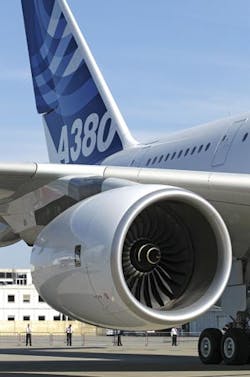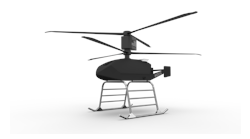Today turbine engines power the majority aircraft. These engines have come to play a significant part in aviation. We will take a look back in time and examine some historical developments and inventions that have led to today’s gas turbine engine technology.
The Aeolipile
We can go all the way back to Egyptian times for the roots of gas turbine history. One might even say this early discovery was heroic. You see, Hero was an Egyptian scientist and mathematician from Alexandria who developed the first “jet engine” around 150 BC. His basic engine was designed to be a toy and was known as the “aeolipile.” It consisted of a boiler, two hollow bent tubes mounted to a sphere, and the sphere. Steam coming from the boiler entered through the two hollow tubes that supported the sphere. The steam then exited through the bent tubes on the sphere, causing the sphere to spin.
Rockets
The Chinese are credited with discovering rocket technology. Rockets were used as early as 1232 by the Mongols to create fear among enemy troops. In what could be one of the earliest Darwin Award finalists, a Chinese scholar, Wan Hu attempted to propel his sled with rockets. His attempt was unsuccessful and led to his death. Rockets were used in the Napoleonic Wars and in the War of 1812. The Germans used V-2 rockets extensively during World War II.
Chimney Jack
Leonardo Da Vinci also has ties to gas turbine history. He designed a machine called the “chimney jack” around 1500 AD. The chimney jack was used to turn a roasting skewer. Heat from the fire would rise up and pass through fan-like blades in the chimney. These blades would then turn a series of gears to turn the skewer.
Branca’s Stamping Mill
In 1629 Italian engineer Giovanni Branca invented an impulse turbine. His invention was a stamping mill. Power was generated by a steam-powered turbine. A nozzle directed steam onto a turbine wheel, which then turned a series of gears to operate his mill.
Newton’s Contributions
In 1687, Sir Isaac Newton announced his three laws of motion. These laws would have a significant impact on future inventions including development of the gas turbine engine.
Newton’s First Law states that every object in a state of uniform motion tends to remain in that state of motion unless an external force is applied to it.
Newton’s Second Law states that the relationship between an object’s mass m, its acceleration a, and the applied force F is F = ma. Acceleration and force are vectors (as indicated by their symbols being displayed in slant bold font); in this law the direction of the force vector is the same as the direction of the acceleration vector.
Newton’s Third Law is the one most familiar to us and states that for every action there is an equal and opposite reaction.
Also in 1687 Newton invented a steam wagon. Newton propelled the wagon by generating steam in a boiler on the wagon. This steam was then directed aft through a nozzle. Although the theory sounded good on paper, the vehicle didn’t work because there was inadequate power generated from the escaping steam.
First Gas Turbine Patent
In 1791 John Barber (an Englishman) patented the first gas turbine engine. His design was planned to propel a “horseless carriage.” Barber’s design used the thermodynamic cycle we are familiar with in the modern gas turbine — it had a compressor, a combustion chamber, and a turbine.
Stolze Engine
In 1872 Dr. F. Stolze designed the first true gas turbine engine. Stolze’s engine used a multistage turbine section and a flow compressor. This engine never ran under its own power.
Elling Engine
In 1903, while the Wright brothers were on their way to become the first to powered flight, Aegidius Elling of Norway managed to build the first successful gas turbine using both rotary compressors and turbines.
GE Gas Turbine Division
In 1918, General Electric started a gas turbine division. Dr. Stanford A. Moss developed the GE turbosupercharger during WWI. It used exhaust gas from piston engines to drive a turbine wheel. This in turn drove a centrifugal compressor that was used for supercharging.
Whittle Engine
In January 1930 Englishman, Frank Whittle, submitted a patent application for a gas turbine for jet propulsion. His engine, which had a single-stage centrifugal compressor coupled to a single-stage turbine, was successfully bench tested in April 1937.
In 1939 the Air Ministry awarded Power Jets Ltd. (a company with which Whittle was associated) a contract to design a flight engine. In May 1941 the Whittle W1 engine made its first flight mounted on the Gloster Model E28/39 aircraft. This aircraft later achieved a speed of 370 mph in level flight with 1,000 pounds of thrust.
German Developments
While Whittle was working on his engine, Germans Hans von Ohain and Max Hahn patented a jet propulsion engine of their own in 1936. The Ernst Heinkel Aircraft Company adapted their ideas and flew the second aircraft engine of this development in an HE-178 aircraft on Aug. 27, 1939 in what would be the first true jet-propelled aircraft. The Heinkel engine developed 1,100 pounds of thrust and propelled the HE-178 to speeds of more than 400 mph. The engine used a centrifugal flow compressor. Later engine developments produced a more advanced turbine engine that incorporated an axial flow compressor. This turbine was used to power the ME262 jet fighter to 500 mph. These aircraft were introduced in the closing stages of World War II. Modern turbine engine features were introduced on the ME262 engine including blade cooling, ice prevention, and the variable-area exhaust nozzle.
Piston/Turbine Hybrid
Italian Secundo Campiri of the Caproni Company invented a turbine engine that used a reciprocating engine to drive its three-stage compressor. This turbine was installed in the Caproni-Campiri CC-2. The aircraft was only able to achieve 205 mph. In August 1940 the CC-2 made its maiden flight, with the whole project ending eight years later.
Another German Development
In 1942, German Scientist Dr. Franz Anslem developed the axial flow turbojet, the Junkers Jumo 004, which was used in the Messerschmitt ME 262, the world’s first operational jet fighter.
American In-Roads
With the help of the British, America entered the jet propulsion field in September 1941. The Wright WlX engine, a complete set of plans for the W2B engine, and a group of Power Jets engineers were flown to the United States from Britain. A contract was awarded General Electric Corp. to develop an American version of The W1X. One year later (October 1942) the Bell XP-59A, fitted with two General Electric l-A engines (rated at 1,300 pounds of thrust each) made this country’s first jet propulsion flight.
Although GE introduced America to jet propulsion with its modified Whittle design, Westinghouse Corp. gave America its own gas turbine engine. The Westinghouse engine included an axial compressor and an annular combustion chamber. These two Westinghouse designs (axial compressor and annular combustion chamber) or variations thereof are still being used in turbine engines.
Today, developments continue in gas turbine technology. Two of the largest gas turbine engines ever built are preparing to enter service in the near future on the Airbus A380 — the Rolls-Royce Trent 900 and the Engine Alliance (GE and Pratt & Whitney partnership) GP 7200. These massive engines will be producing 70,000 pounds of thrust each. In the future, it will be interesting to see the role these engines play in gas turbine engine development.


